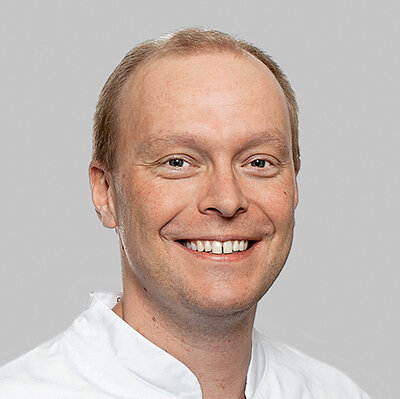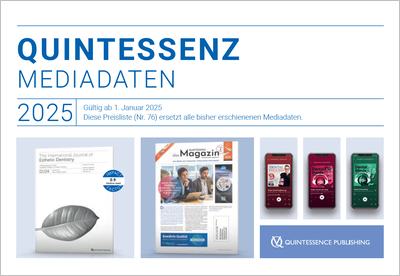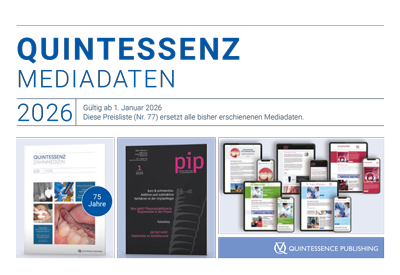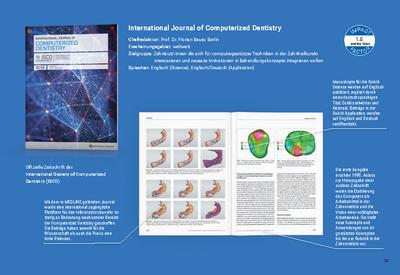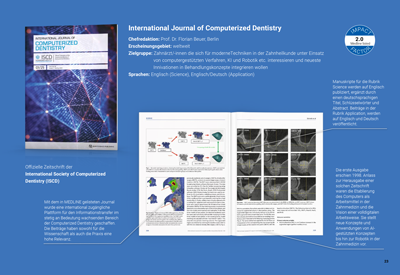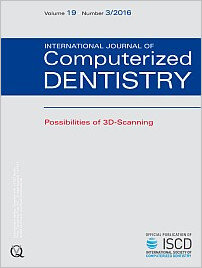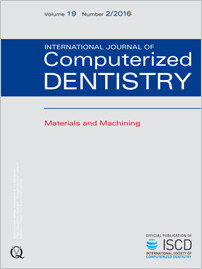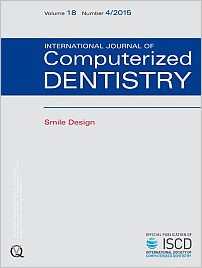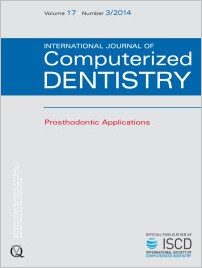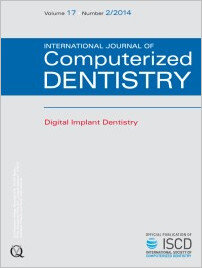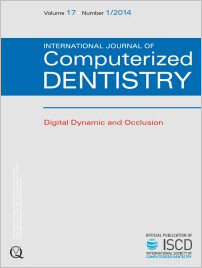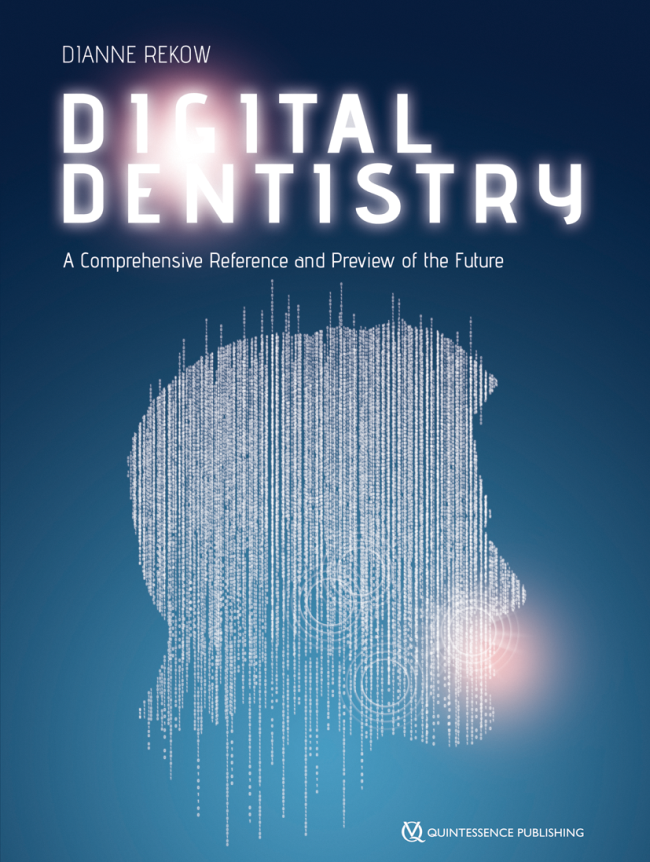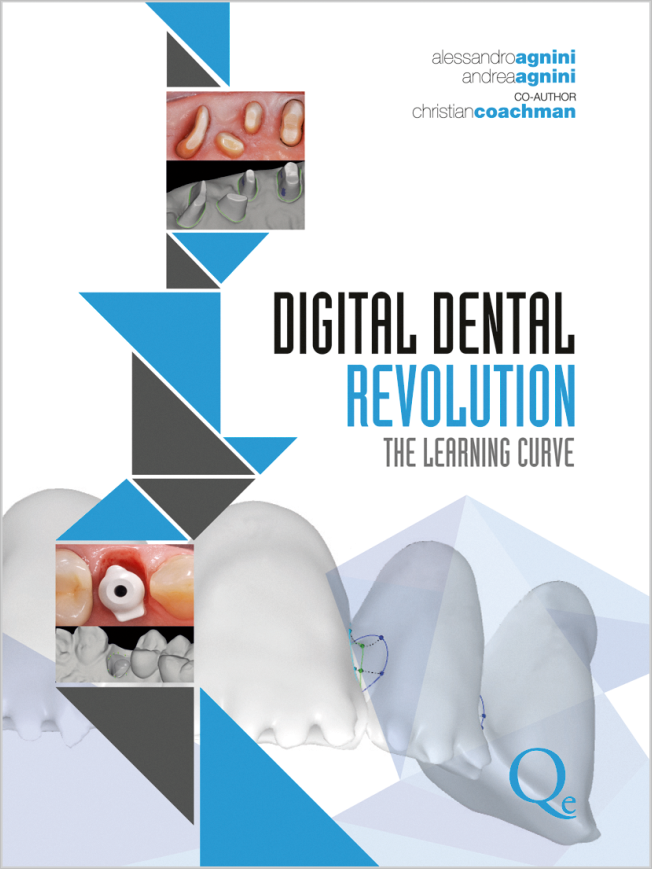PubMed ID (PMID): 27644176Pages 187-188, Language: English, GermanMehl, AlbertPubMed ID (PMID): 27644177Pages 193-202, Language: English, GermanMatsuda, Takashi / Goto, Takaharu / Kurahashi, Kosuke / Kashiwabara, Toshiya / Ichikawa, TetsuoObjectives: We developed an innovative procedure for digitizing maxillary edentulous residual ridges with a photogrammetric system capable of estimating three-dimensional (3D) digital forms from multiple two-dimensional (2D) digital images. The aim of this study was to validate the effectiveness of the photogrammetric system.
Materials and methods: Impressions of the maxillary residual ridges of five edentulous patients were taken with four kinds of procedures: three conventional impression procedures and the photogrammetric system. Plaster models were fabricated from conventional impressions and digitized with a 3D scanner. Two 3D forms out of four forms were superimposed with 3D inspection software, and differences were evaluated using a least squares best fit algorithm.
Results: The in vitro experiment suggested that better imaging conditions were in the horizontal range of ± 15 degrees and at a vertical angle of 45 degrees. The mean difference between the photogrammetric image (Form A) and the image taken from conventional preliminarily impression (Form C) was 0.52 ± 0.22 mm. The mean difference between the image taken of final impression through a special tray (Form B) and Form C was 0.26 ± 0.06 mm. The mean difference between the image taken from conventional final impression (Form D) and Form C was 0.25 ± 0.07 mm. The difference between Forms A and C was significantly larger than the differences between Forms B and C and between Forms D and C.
Conclusion: The results of this study suggest that obtaining digital impressions of edentulous residual ridges using a photogrammetric system is feasible and available for clinical use.
Keywords: digital dentistry, complete denture, edentulous, photogrammetric system, digital impression, scanner
PubMed ID (PMID): 27644178Pages 203-215, Language: English, GermanJung, Yoo-Ran / Park, Ji-Man / Chun, Youn-Sic / Lee, Kkot-Nim / Kim, MinjiObjective: The objective of this study was to compare the accuracy of four different digital intraoral scanners and the effects of buccal brackets and orthodontic wire.
Methods: For this study, three sets of models (Control model, BKT model with buccal bracket, and WBKT model with buccal bracket and orthodontic wire) were scanned using four different types of intraoral scanners: E4D dentist, iTero, Trios, and Zfx IntraScan. The mesiodistal width of the teeth, intercanine width, and intermolar width measured by four scanners were compared. Three-dimensional (3D) images of the brackets were taken using the four scanners. Data were analyzed with one-way ANOVA, independent t test, and post-hoc Tukey test at a significance level of P 0.05.
Results: When comparing the 3D images with manual measurements using a traditional caliper, iTero and Trios showed the highest accuracy in horizontal measurements.iTero had the lowest values in Devmax-min of maxillary intermolar and intercanine widths (0.16 mm and 0.20 mm, respectively), whereas Trios had the lowest values in Devmax-min of mandibular intermolar and intercanine widths (0.36 mm and 0.14 mm, respectively). The horizontal variables were barely affected by the presence of buccal brackets and orthodontic wire. Comparison of 3D bracket images scanned by the four scanners showed differences in image distortion among the scanners. Bracket characteristics did not affect the 3D bracket images.
Conclusions: The four intraoral scanners used in this study differed in accuracy. However, the results acquired by iTero and Trios were more reliable. Effects of buccal brackets and orthodontic wire on the 3D images taken by intraoral scanners were not clinically significant.
Keywords: intraoral scanners, buccal brackets, accuracy, orthodontic wire, horizontal distortion, 3D images
PubMed ID (PMID): 27644179Pages 217-230, Language: English, GermanPeters, Florian / Möhlhenrich, Stephan Christian / Ayoub, Nassim / Goloborodko, Evgeny / Ghassemi, Alireza / Lethaus, Bernd / Hölzle, Frank / Modabber, AliThere are many possibilities for the use of three-dimensional (3D) scanners in maxillofacial surgery. This study aimed to investigate whether the bundling and syncing of two 3D scanners has advantages over single-scanner acquisition in terms of scan quality and the time required to scan an object.
Therefore, the speed and precision of 3D data acquisition with one scanner versus two synced scanners was measured in 30 subjects. This was done by analyzing the results obtained by scanning test objects attached to the forehead and cheeks of the subjects. Statistical methods included the Student t test for paired samples.
Single-scanner recording resulted in significantly lower mean error of measurement than synced recording with two scanners for length (P 0.001), all frontal/lateral plane angles (P = 0.034, P 0.001, P = 0.002, P = 0.003), and side/side plane angles (P = 0.014, P 0.001, P = 0.015, P = 0.011) of the test object on the cheek. Likewise, the single-scanner method resulted in a significantly lowermean error of measurement than the two-scanner method for frontal/lower plane angles (P 0.001), right/lower plane angles (P 0.001), and left/lower plane angles (P = 0.002). Conversely, synced recording of data with two scanners resulted in a significant reduction of scanning time (P 0.001).
Compared to data acquisition with a single 3D scanner, the bundling of two 3D scanners resulted in faster scanning times but lower scan quality.
Keywords: mobile 3D scanner, precision, Artec Eva, facial scanner, scan quality
PubMed ID (PMID): 27644180Pages 231-238, Language: English, GermanReich, Sven / Peters, Florian / Schenk, Olaf / Hartkamp, OliverThe face scan can serve as a means for the visualization of planes relevant for extensive prosthetic reconstructions. The key prerequisite is the availability of data in stl format for further processing in different software programs. The method is described in this article by a patient case.
Keywords: face scan, reconstruction, prosthetic planes, digital impression, registration
Digital extra printPubMed ID (PMID): 27644181Pages 239-255, Language: English, GermanSchneider, OliverAn 8-year clinical studyThe experienced Cerec user can manufacture high-quality, esthetic anterior and posterior bridges from IPS e.max CAD in a manageable 3-hour chairside session. On the basis of over 8 years of experience, it can be said that these restorations are clinically very well proven, provided they are used within the range of recommended indications. Experimental retainer bridges with extensions can be seen as highly interesting alternatives, although more clinical data are required for further confirmation.
Keywords: all-ceramic, Cerec, chairside treatment, bridge prosthetics, adhesive cementation, retainer bridges with extensions
PubMed ID (PMID): 27644182Pages 257-279, Language: English, GermanKurbad, AndreasThe use of materials with elastic properties for the fabrication of dental implant superstructures seems to be a promising way to reduce the functional occlusal forces on implants. Vita Enamic (Vita Zahnfabrik, Bad Säckingen), a hybrid ceramic material for CAD/CAM technology, is available in a special form that can be relatively easily combined with titanium (Ti) base connectors for the fabrication of abutment crowns and mesostructures. Thus, an easily manageable method is available for reducing peak loads on dental implant fixtures. Representative cases are presented to demonstrate the clinical workflows for a single- element solution (Ti base) and two-element solution (Ti base with mesostructure) for implant-supported crowns.
Keywords: dental implant, abutment, mesostructure, CAD/CAM, ceramic, hybrid ceramic
